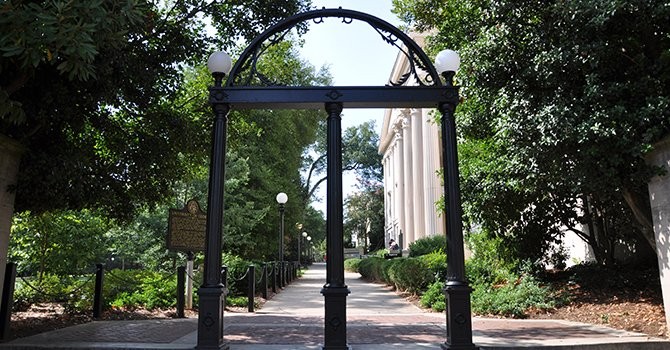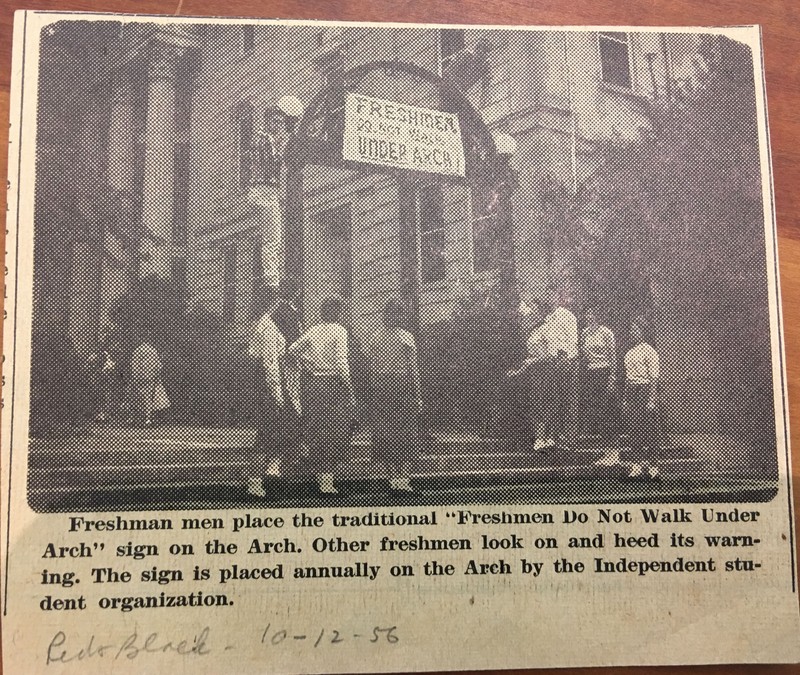The University of Georgia Arch
Introduction
Text-to-speech Audio
Images
The Arch as it stands today.

The Arch as it looked in 1956.

Backstory and Context
Text-to-speech Audio
The Foundry was established in 1850 as the Athens Steam Company with Richard S. Schevenell, the owner of a cabinet and coach making business, as president and John Smith as its agent. Other founding members were Rufus L. Moss (a director at a bank and the owner of a fire department company), Peter A. Sumney, and John S. Linton, and these successful businessmen started with a capital stock of $5,000. The company manufactured a wide variety of mill machinery, steam engines, shafting, and pulleys, but they specialized in iron and brass castings like the fence that surrounds the North side of the University of Georgia. They began advertising to gather stockholders in February 1851, and they put out their first ad in the Southern banner on November 6 of the same year. Within the next decade, they were able to advertise the newest models of water wheel turbines, cotton presses, cotton seed planters, and other iron works. In the 1860s, Athens Steam Company became Athens Foundry and Machine Works. During that time, R. Nickerson served as the company’s agent/superintendent and personally oversaw the company’s “hardware, iron, steel, and agricultural implement manufacturing.”
Along with payments for high-profile jobs like constructing a fence for the University of Georgia, Athens Steam Company also benefited from unpaid slave labor. Specific details about slave labor within Athens Steam Company are unknown, but we can rely on E. Merton Coulter’s account of the general situation of slaves in antebellum Athens. During this period, the proportions of white and Black Athenians were almost identical, and virtually all Black residents were enslaved. Though white residents saw themselves as benevolent masters, they lived in fear of an insurrection among those African-Americans “employed” at places like the Foundry, where white and Black workers often worked in the same building. As economical as slave labor could be, however, not all workers who could have built the Arch were enslaved. Mr. Thomas Bailey, a white man, began his career at the Athens Steam Company by working on the iron railing surrounding Broad Street, and he later became general manager of the company after serving as a foreman for the Confederacy and merging his own foundry with the company.
The construction of the Arch is one example of how unpaid slave labor greatly bolstered the economies of Georgia and the American South as a whole. Georgians fiercely sought to maintain their right to own slaves in the period preceding the Civil War. When the Civil War broke out, some students at the University of Georgia fought with Georgia’s Confederates, and the school struggled to stay open due to a lack of demand (as only white men could attend the institution at the time). The Foundry designed and supplied Confederate Athens with the double-barreled cannon in 1863. It was a massive failure and is much more useful as a sightseeing attraction for the city than it ever was as a method of defense.
Today, the Arch is thought of as separate from the surrounding fencing. Despite appearing timeless, it has been restored as recently as 2015 in order to preserve its historic characteristics. The fence extending from Broad Street to surround all North Campus was extended that far by a new company that took up residence in the same building in 1945, which was known as the Athens Boiler and Machine Works. The three pillars have become a symbol of both the University of Georgia and, ironically, the founding principles of the state: wisdom, justice, and moderation. The Foundry now serves as a music venue and hotel with a ballroom to host special events, including those organized by university students. It markets its history as an added layer of texture and Southern flair to a business that, though reasonably successful, bears no resemblance to the building’s original purpose.
Sources
“A Card.” The Southern Banner (Athens, Georgia), February 6, 1851.
“Clarke County.” The Southern Watchman (Athens, Georgia), January 7, 1858.
Coulter, E. Merton. “Slavery and Freedom in Athens, Georgia, 1860-1866.” The Georgia Historical Quarterly (1965): 265.
“Double-Barreled Cannon.” Athens-Clarke County Unified Government. Retrieved December 3, 2019 from https://athensclarkecounty.com/86/Double-Barreled-Cannon
Dyer, Thomas G. The University of Georgia: A Bicentennial History. Athens, Georgia: University of Georgia Press, 1985.
“Georgia, Clarke County.” The Southern Banner (Athens, Georgia), January 16, 1852.
Hynds, Ernest C. Antebellum Athens and Clarke County, Georgia. Athens, Georgia: University of Georgia Press, 1974.
“New Fence to Run from Broad Street to Joe Brown Dorm.” The Red and Black (Athens, Georgia), February 9, 1945.
“Notice!” The Banner-Herald (Athens, Georgia), February 26, 1928.
“Richard S. Schevenell.” The Southern Banner (Athens, Georgia), July 18, 1844.
“The Athens Foundry and Machine Works. A Leading Industry in the City of Athens.” The Athens Banner (Athens, Georgia), December 20, 1902.
“The Athens Foundry and Machine Works.” Broadside. 1869. Retrieved from the Hargrett Library, University of Georgia.
“The Athens Steam Company.” The Southern Banner (Athens, Georgia), November 13, 1851.
The Southern Herald (Athens, Georgia), October 17, 1850.
Wilson, Samuel B. “Historic landmark undergoes preservation work.” The Red and Black (Athens, Georgia), June 3, 2015.
Haley Higingbotham. "The Arch." Clio: Your Guide to History. April 30, 2018. Accessed November 11, 2019. https://theclio.com/entry/58980
Haley Higingbotham. "The Arch." Clio: Your Guide to History. April 30, 2018. Accessed November 11, 2019. https://theclio.com/entry/58980
